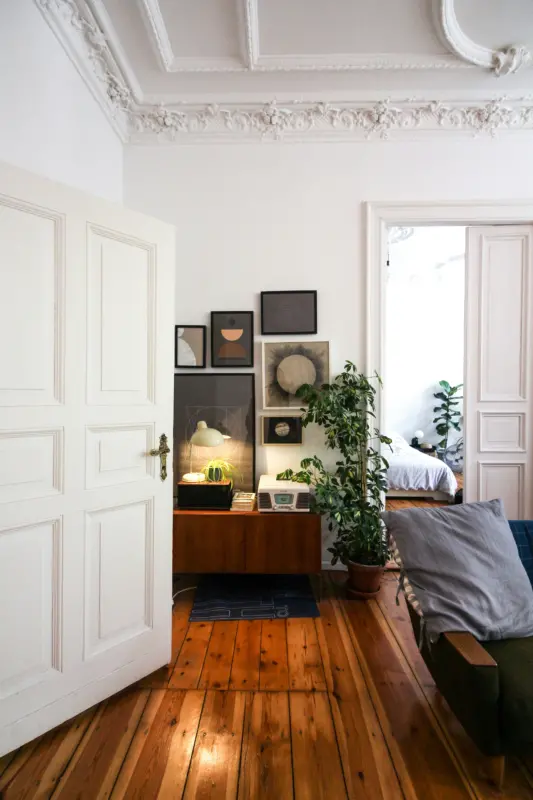Botanical name
Pinus sylvestris
Growth area
Pine is widespread in Russia, Europe, North America, and North Asia. It forms both mixed and pure forests. In Russia, 1/6 of all forests are occupied by this species. It is not found in South America, Australia, and Africa (only a little in the continent’s north).
Varieties
Scotch pine, Siberian cedar, Korean cedar, Elfin cedar, Crimean pine, Italian pine (from Madeira to the Caucasus), Mountain pine (from the Pyrenees to the Caucasus), Weymouth pine (North America), Lambert Pine (North America).
Structure
Cross-section of a pine tree
Pine height reaches 60-140ft. Its wood is light with a pale yellowish-brown resinous heartwood, distinct from the wide sapwood, which has a pale pink tint. The texture is uniform, with a difference in the color of early and latewood. Veins are resinous, orange-red. Knots give expressiveness to the structural pattern.
The growing conditions of a tree affect the quality of wood, its performance, and its texture. The best material is obtained from trees growing on uplands and dry sandstones. The wood has a dense structure due to closely spaced annual rings. Pine growing in damp places has a loose design.

Pine – veneer, tree in nature
The wood is soft and easy to process but chipped and easily damaged. Requires a sharp tool for processing. It is well planned along the fibers and difficult across, but it is sawn, on the contrary, poorly along the fibers and well across. Pinewood sticks well.

Mechanical indicators
Pine is softwood, which means it has low wear resistance. It weakly holds metal fasteners. Easily attacked by fungi.
Usage
Pine is used to manufacture furniture, joinery frames, and structures for a veneer. Pinewood is used to manufacture doors, floors, windows, veneer, plywood, turnery, etc. It can be easily painted and varnished.
Almost all interior doors with coatings (veneered, laminated, PVC) have a pine frame in their design.
Pine timber in the frame of an interior door
The cheapest option is solid pine doors. Since pine is a hygroscopic species, this creates specific difficulties in the operation of such products since when climatic factors (temperature, humidity) change, the elements of the door block can change their dimensions. Therefore, such doors must be treated with water-repellent compounds – synthetic or oil varnishes, polymer coatings. The ends of the vertical bars should be especially carefully protected, as they are the most vulnerable places for moisture absorption.
Natural wood is a somewhat inconsistent material. Only parts made of wood of the same type can come into contact with each other. So, for example, solid pine doors should only be covered with pine veneer. Covering the pine frame with an oak veneer will not please you for long – it will delaminate and crack. To avoid such problems, manufacturers use a layer in the form of an MDF sheet between the array and the veneer, strengthening the structure and reducing the likelihood of drying out and deformation.


 All Interior Doors
All Interior Doors Prehung Doors
Prehung Doors Doors By Style
Doors By Style Doors By Room
Doors By Room Sliding Doors
Sliding Doors Doors By Color
Doors By Color Bi-Fold Doors
Bi-Fold Doors French Interior Doors
French Interior Doors All Exterior Doors
All Exterior Doors Steel Security Doors
Steel Security Doors Fiberglass Doors
Fiberglass Doors Wrought Iron Doors
Wrought Iron Doors Aluminum Windows
Aluminum Windows Vinyl Windows
Vinyl Windows Wood Windows
Wood Windows Tables
Tables Accessories
Accessories Magic Door Hardware
Magic Door Hardware Magnetic Door Hardware
Magnetic Door Hardware Entry Handle sets
Entry Handle sets Barn Door Hardware
Barn Door Hardware Pocket Door Hardware
Pocket Door Hardware Door Levers
Door Levers Magnetic Locks
Magnetic Locks Hinges
Hinges Bathroom Mirrors
Bathroom Mirrors Wall-Mounted Vanities
Wall-Mounted Vanities















 Steel Security Doors
Steel Security Doors